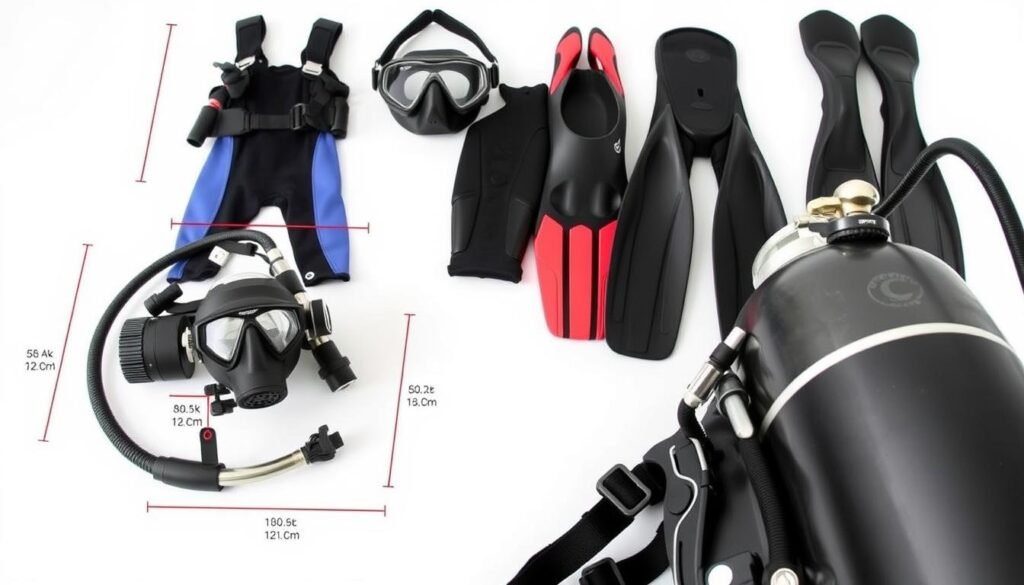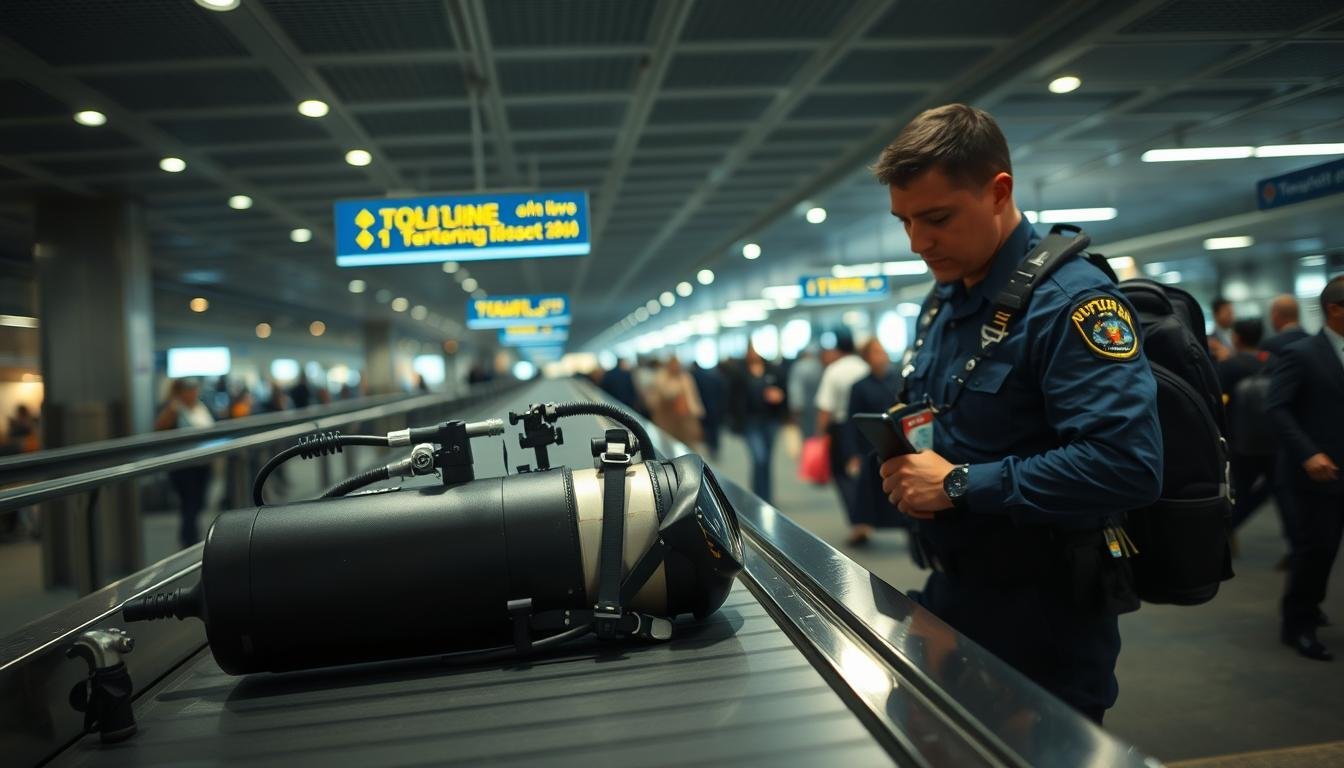Bringing Scuba Gear on a Plane: Planning a diving trip is more than just booking flights and hotels. Transporting your scuba equipment can be tricky due to rules and limits.
Airlines and security groups, like the TSA, have clear rules for scuba gear on planes. Knowing these rules helps make your trip smoother.
Before your next dive, learn about scuba gear air travel rules and how to pack. This way, you’ll avoid problems at check-in or security.
Contents
- 1 Understanding Air Travel with Scuba Equipment
- 2 Can You Bring Scuba Gear on a Plane? TSA Regulations
- 3 Airline-Specific Policies for Scuba Equipment
- 4 Packing Your Dive Gear: Checked Baggage vs. Carry-On
- 5 Protecting Your Equipment During Transit
- 6 Weight and Size Limitations for Scuba Gear
- 7 Tips for Hassle-Free Travel with Dive Equipment
- 8 Conclusion: Bringing Scuba Gear on a Plane
- 9 FAQ
- 9.1 What are the TSA regulations for scuba tanks on a plane?
- 9.2 Can I bring my BCD on a plane as carry-on?
- 9.3 How do I protect my scuba gear during transit?
- 9.4 What are the weight and size limitations for scuba gear on a plane?
- 9.5 Can I bring my scuba regulator on a plane?
- 9.6 Do I need to declare my scuba gear at check-in?
- 9.7 Can I bring diving certifications and documents on a plane?
- 9.8 Are there any additional fees for checking scuba gear?
Understanding Air Travel with Scuba Equipment
Knowing the rules for flying with scuba gear can save you from airport hassles. The Transportation Security Administration (TSA) has clear guidelines for different scuba gear types.
The TSA lets you bring some scuba gear in your carry-on or checked luggage. But, there are items that need special care or can’t go in carry-ons.
| Scuba Gear Item | Carry-On Allowance | Checked Baggage Allowance |
|---|---|---|
| Scuba Tanks | No | Yes, with proper packaging |
| Regulators | Yes | Yes |
| BCDs | Yes | Yes |
Always check with your airline about their scuba gear policies. They might have extra rules you need to follow.
Can You Bring Scuba Gear on a Plane? TSA Regulations
The Transportation Security Administration (TSA) has rules for scuba gear. Knowing these rules is key before your trip. It helps make sure your scuba gear gets to your destination safely.
The TSA has rules for scuba gear in carry-on bags, checked luggage, and what’s not allowed. For example, scuba tanks can go in checked bags but must be packed right and told to the airline.
Specific Items Allowed or Prohibited
Some scuba gear items have special rules.
– Empty scuba tanks are okay in checked bags if they have no air left.
– Regulators and BCDs can go in both carry-on and checked bags.
– Dive knives and sharp objects might have rules and are best in checked bags.
Always check the TSA’s website for the latest rules. Also, some airlines have their own rules, so it’s good to ask them too.
To travel smoothly, pack your scuba gear well and tell the airline about it. Knowing TSA rules can greatly improve your trip with scuba gear.
Airline-Specific Policies for Scuba Equipment
Before you travel, it’s key to know your airline’s rules for scuba gear. The TSA gives general advice, but each airline has its own rules. These can vary a lot.
Some airlines might have special rules for how you pack, the size, or the weight. For example, some might need your gear in a certain bag or box. Others might charge extra for heavy or big items. They might also limit how much you can check.
Checking with your airline before travel can prevent problems at the airport. You can find this info on their website, in the baggage policy section.
It’s smart to call the airline’s customer service if you’re not sure about their rules. Doing this ahead of time can make your travel day smoother.
Packing Your Dive Gear: Checked Baggage vs. Carry-On
When you’re getting ready to fly with your scuba gear, you have to decide between checking it or carrying it on. This choice depends on your gear, the airline’s rules, and what you prefer for keeping your gear safe and easy to get to.
Checked baggage is good for big items like wetsuits, BCDs, and regulators. But, always check with your airline about their rules for scuba gear. Some airlines might have size, weight limits, or need special care for your gear.
Protecting Fragile Items
It’s important to keep fragile items safe, no matter if you check or carry them. This includes your regulator, BCD inflator, and other delicate parts. Use protective cases or wrapping to protect these items from bumps.
| Consideration | Checked Baggage | Carry-On |
|---|---|---|
| Size and Weight Restrictions | Varies by airline; often more lenient | Strict limits; must fit in overhead bin or under seat |
| Risk of Damage or Loss | Higher risk due to handling | Lower risk as it’s kept with you |
| Accessibility | Limited access during flight | Easily accessible during travel |
Carrying on valuable or essential items can help avoid loss or damage. But, you need to plan carefully to fit within carry-on size and weight limits.
In summary, choosing to check or carry your scuba gear depends on your gear, airline rules, and what matters most to you. By thinking about these things and taking the right steps to protect your gear, you can make sure it arrives safely at your destination.
Protecting Your Equipment During Transit
Traveling with scuba gear means you need to protect it well. This is to make sure it gets to your destination without damage. Damage can be expensive to fix or replace, and might even make your gear unusable.
Use protective cases or bags made for scuba gear to transport it safely. These often have padding and compartments. They help keep your gear organized and secure.
When packing, secure loose items well. Use bubble wrap or foam inserts for fragile parts like regulators and gauges. Disassembling big items, like BCDs, makes them easier to pack and more compact.
Think about the weight and size of your gear when choosing a case or bag. A sturdy, well-padded case protects against impacts and scratches. Proper packing and protection help keep your scuba gear in top shape during your trip.
By following these tips, you can have a worry-free trip with your dive equipment. You’ll know it’s safely transported and ready for your next dive.
Weight and Size Limitations for Scuba Gear
To travel smoothly with your scuba gear, knowing airline weight and size limits is key. Going over these limits can lead to extra fees or needing to re-pack at the airport.
Airlines have rules for both checked and carry-on bags. Checked bags usually can’t weigh more than 50 pounds (23 kg). But, the size of your scuba gear matters too. Big items like BCDs or wetsuits might be too big for airline sizes.

Before you go to the airport, measure and weigh your scuba gear. Use a luggage scale to check the weight and measure the size. This ensures your gear fits airline rules.
Common Weight and Size Limits for Scuba Gear
| Airline | Checked Baggage Weight Limit | Checked Baggage Size Limit |
|---|---|---|
| American Airlines | 50 pounds (23 kg) | 62 inches (157 cm) |
| Delta Air Lines | 50 pounds (23 kg) | 62 inches (157 cm) |
| United Airlines | 50 pounds (23 kg) | 62 inches (157 cm) |
Always check with your airline about their scuba gear policies. Some airlines have stricter rules than others. It’s best to confirm before your trip.
Following these weight and size rules helps avoid check-in problems. It also makes sure your scuba gear gets to your destination safely.
Tips for Hassle-Free Travel with Dive Equipment
Traveling with dive equipment can be easy if you know the airline rules and pack smart. First, always check with your airline about their scuba gear policies.
Airlines have different rules for carrying on, checking, and extra fees for dive gear. Knowing these rules ahead of time helps avoid surprises at the airport.
It’s important to pack your gear right. Use a hard-sided case to keep it safe during travel. Pack your regulator, BCD, and wetsuit in a way that’s easy to check but still protected.
Arriving early at the airport is another key tip. It gives you time for check-in and security, even if there are any last-minute issues with your gear.
Here are some more tips to remember:
- Label your equipment clearly with your name and contact information.
- Consider packing a dive gear repair kit with essentials like duct tape and O-rings.
- Check the weather and dive conditions at your destination to pack the right gear.
By following these simple yet effective tips, you can have a stress-free trip with your dive equipment. You’ll get to enjoy your diving adventure without worrying about your gear.
Conclusion: Bringing Scuba Gear on a Plane
Now you know the rules for flying with dive gear. This knowledge lets you plan your diving trip confidently. You’ll understand TSA rules and airline policies to travel smoothly with your scuba gear.
It’s important to pack and protect your gear well to avoid damage. Also, know the weight and size limits for your scuba gear to avoid extra fees or problems.
Following the tips in this article will make your travel easy. Whether you’re an experienced diver or new, being ready is key. It helps you enjoy your diving trip without worrying about your gear.
With good planning and attention to detail, flying with scuba gear is easy. You can then focus on enjoying your diving adventure.
See Also: Can You Bring Adult Diapers on a Plane?
FAQ
What are the TSA regulations for scuba tanks on a plane?
Scuba tanks can go in checked baggage. They must be packed right and follow certain rules. The tank needs to be empty of air, and the valve must be taken off or made useless.
Can I bring my BCD on a plane as carry-on?
It depends on the airline’s rules and your BCD’s size. Some airlines let BCDs in carry-on, others need them checked. Always check with your airline before your trip.
How do I protect my scuba gear during transit?
To keep your gear safe, use a strong case or a padded bag. Wrap fragile items like regulators in clothes or bubble wrap. Use cable ties or zip ties to keep loose items in place.
What are the weight and size limitations for scuba gear on a plane?
Weight and size limits differ by airline. Most have rules for checked and carry-on bags. Check with your airline for your gear’s max weight and size.
Can I bring my scuba regulator on a plane?
Yes, you can take scuba regulators in carry-on or checked bags. But, it’s best to put them in a protective case to avoid damage.
Do I need to declare my scuba gear at check-in?
Yes, tell the airline about your scuba gear at check-in. This way, they know about it and can help with their rules and procedures.
Can I bring diving certifications and documents on a plane?
Yes, take your diving certifications and documents with you. You might need to show them to your dive operator or other authorities during your trip.
Are there any additional fees for checking scuba gear?
Some airlines charge extra for checking scuba gear, especially if it’s big or heavy. Check with your airline to see their fees and policies.

Hello, I’m Janiyah Gibbs—a retired flight crew member and former TSA officer from Alaska, USA. At PlaneCarry.com, I share expert insights on what to carry (and avoid) when flying.

